technical data SKODA YETI 2010 1.G / 5L Owner's Guide
[x] Cancel search | Manufacturer: SKODA, Model Year: 2010, Model line: YETI, Model: SKODA YETI 2010 1.G / 5LPages: 271, PDF Size: 14.71 MB
Page 62 of 271
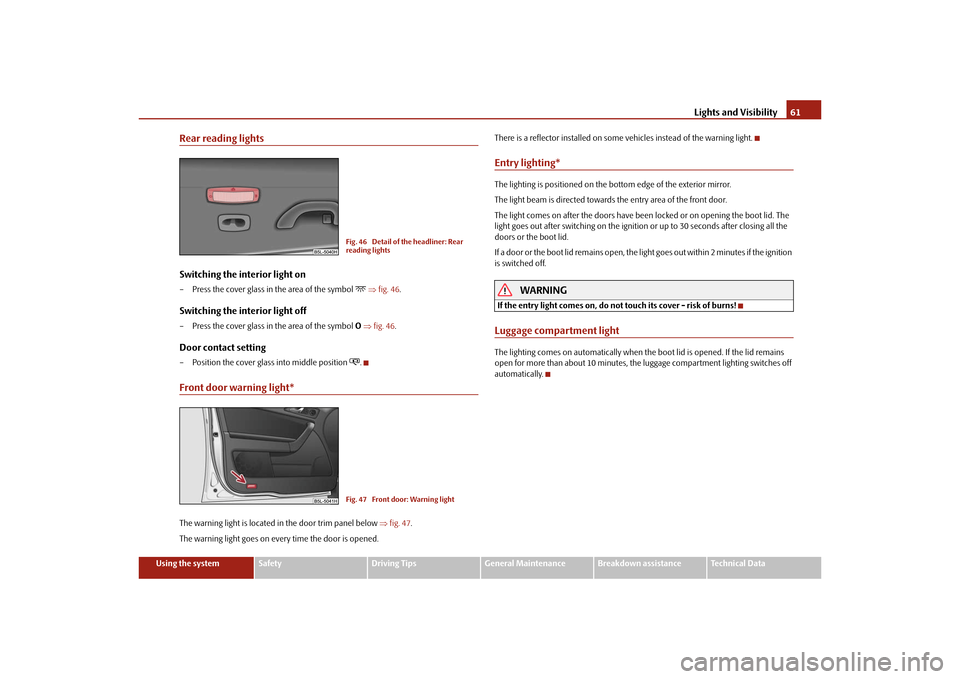
Lights and Visibility61
Using the system
Safety
Driving Tips
General Maintenance
Breakdown assistance
Technical Data
Rear reading lightsSwitching the interior light on– Press the cover glass in the area of the symbol
fig. 46 .
Switching the interior light off– Press the cover glass in the area of the symbol O fig. 46 .Door contact setting– Position the cover glass into middle position
.
Front door warning light*The warning light is located in the door trim panel below fig. 47 .
The warning light goes on every time the door is opened. There is a reflector installed on some vehicles instead of the warning light.
Entry lighting*The lighting is positioned on the bottom edge of the exterior mirror.
The light beam is directed towards
the entry area of the front door.
The light comes on after the doors have been locked or on opening the boot lid. The
light goes out after switching on the ignition or up to 30 seconds after closing all the
doors or the boot lid.
If a door or the boot lid remains open, the light goes out within 2 minutes if the ignition
is switched off.
WARNING
If the entry light comes on, do not touch its cover - risk of burns!Luggage compartment lightThe lighting comes on automatically when th e boot lid is opened. If the lid remains
open for more than about 10 minutes, the luggage compartment lighting switches off
automatically.
Fig. 46 Detail of the headliner: Rear
reading lightsFig. 47 Front door: Warning light
s2ug.6.book Page 61 Friday, April 9, 2010 2:24 PM
Page 64 of 271
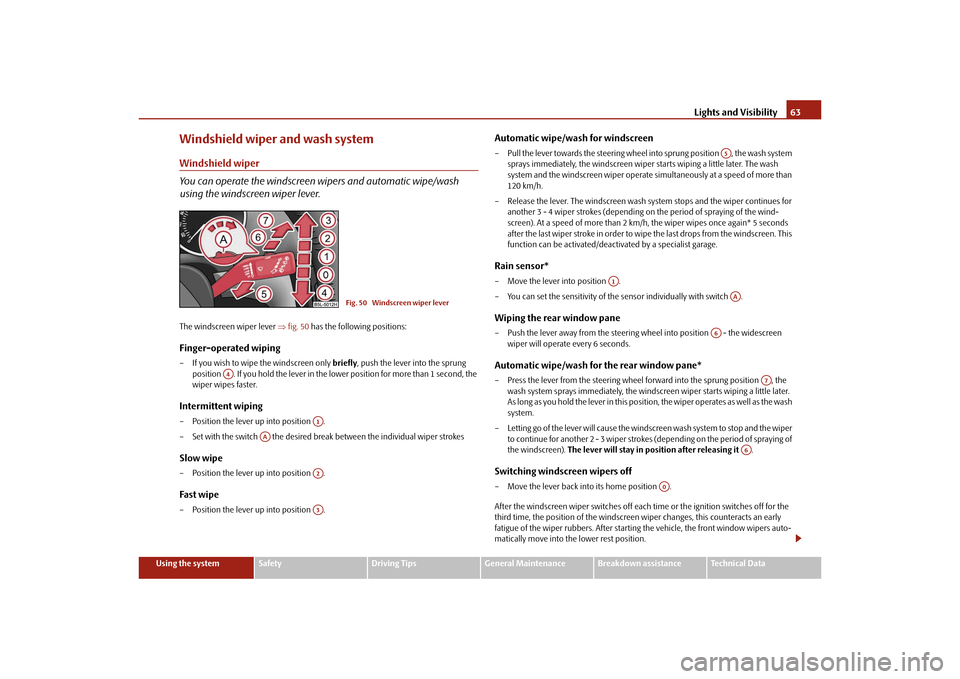
Lights and Visibility63
Using the system
Safety
Driving Tips
General Maintenance
Breakdown assistance
Technical Data
Windshield wiper and wash systemWindshield wiper
You can operate the windscreen wipers and automatic wipe/wash
using the windscreen wiper lever.The windscreen wiper lever fig. 50 has the following positions:Finger-operated wiping– If you wish to wipe the windscreen only briefly, push the lever into the sprung
position . If you hold the lever in the lo wer position for more than 1 second, the
wiper wipes faster.Intermittent wiping– Position the lever up into position .
– Set with the switch the desired brea k between the individual wiper strokesSlow wipe– Position the lever up into position .Fast wipe– Position the lever up into position .
Automatic wipe/wash for windscreen– Pull the lever towards the steering wheel into sprung position , the wash system
sprays immediately, the windscreen wiper starts wiping a little later. The wash
system and the windscreen wiper operate simultaneously at a speed of more than
120 km/h.
– Release the lever. The windscreen wash system stops and the wiper continues for another 3 - 4 wiper strokes (depending on the period of spraying of the wind-
screen). At a speed of more than 2 km/h, the wiper wipes once again* 5 seconds
after the last wiper stroke in order to wipe the last drops from the windscreen. This
function can be activated/deacti vated by a specialist garage.Rain sensor*– Move the lever into position .
– You can set the sensitivity of the sensor individually with switch .Wiping the rear window pane– Push the lever away from the steering wheel into position - the widescreen
wiper will operate every 6 seconds.Automatic wipe/wash for the rear window pane*– Press the lever from the steering wheel forward into the sprung position , the wash system sprays immediately, the windscreen wiper starts wiping a little later.
A s l o n g a s y o u h o l d t h e l e v e r i n t h i s p o s i t i o n, th e w i p e r o p e ra t e s a s w e l l a s t h e w a s h
system.
– Letting go of the lever will cause the windscreen wash system to stop and the wiper to continue for another 2 - 3 wiper strokes (depending on the period of spraying of
the windscreen). The lever will stay in position after releasing it .Switching windscreen wipers off– Move the lever back into its home position .
After the windscreen wiper switches off each time or the ignition switches off for the
third time, the position of the windscreen wiper changes, this counteracts an early
fatigue of the wiper rubbers. After starting the vehicle, the front window wipers auto-
matically move into the lower rest position.
Fig. 50 Windscreen wiper lever
A4
A1
AA
A2A3
A5
A1
AA
A6
A7
A6
A0
s2ug.6.book Page 63 Friday, April 9, 2010 2:24 PM
Page 66 of 271
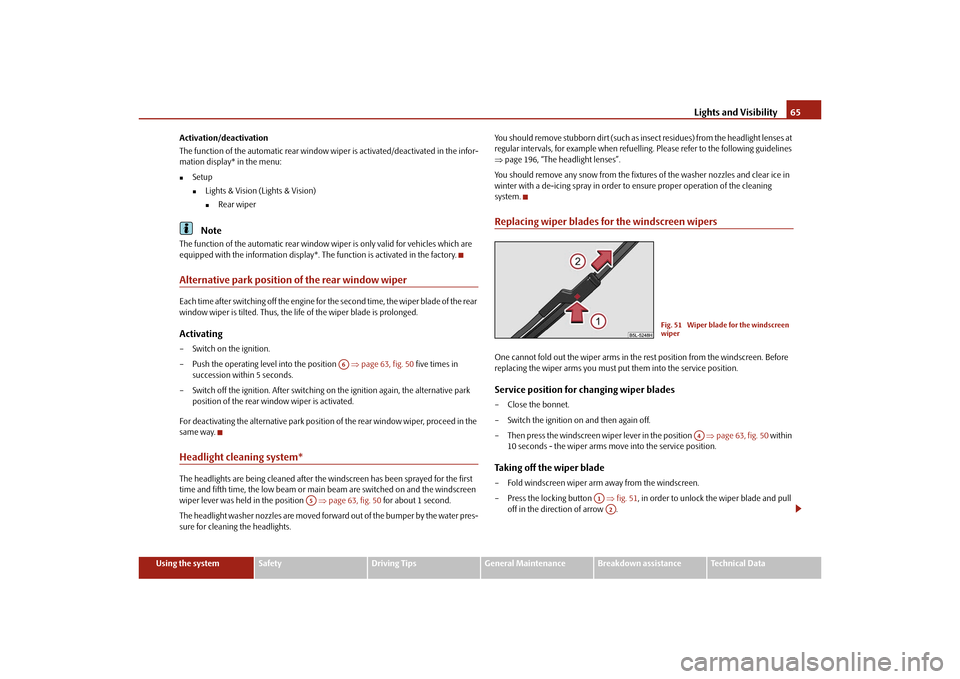
Lights and Visibility65
Using the system
Safety
Driving Tips
General Maintenance
Breakdown assistance
Technical Data
Activation/deactivation
The function of the automatic rear window wiper is activated/deactivated in the infor-
mation display* in the menu:
Setup
Lights & Vision (Lights & Vision)
Rear wiper
Note
The function of the automatic rear window
wiper is only valid for vehicles which are
equipped with the information display*. The function is activated in the factory.Alternative park position of the rear window wiperEach time after switching off the engine for the second time, the wiper blade of the rear
window wiper is tilted. Thus, the life of the wiper blade is prolonged.Activating– Switch on the ignition.
– Push the operating level into the position page 63, fig. 50 five times in
succession within 5 seconds.
– Switch off the ignition. After switching on the ignition again, the alternative park
position of the rear window wiper is activated.
For deactivating the alternative park position of the rear window wiper, proceed in the
same way.Headlight cleaning system*The headlights are being cleaned after the windscreen has been sprayed for the first
time and fifth time, the low beam or main beam are switched on and the windscreen
wiper lever was held in the position page 63, fig. 50 for about 1 second.
The headlight washer nozzles are moved forward out of the bumper by the water pres-
sure for cleaning the headlights. You should remove stubborn dirt (such as in
sect residues) from the headlight lenses at
regular intervals, for example when refuelling . Please refer to the following guidelines
page 196, “The headlight lenses”.
You should remove any snow from the fixtur es of the washer nozzles and clear ice in
winter with a de-icing spray in order to ensure proper operation of the cleaning
system.
Replacing wiper blades for the windscreen wipersOne cannot fold out the wiper arms in the re st position from the windscreen. Before
replacing the wiper arms you must pu t them into the service position.Service position for changing wiper blades– Close the bonnet.
– Switch the ignition on and then again off.
– Then press the windscreen wiper lever in the position page 63, fig. 50 within
10 seconds - the wiper arms move into the service position.Taking off the wiper blade– Fold windscreen wiper arm away from the windscreen.
– Press the locking button fig. 51 , in order to unlock the wiper blade and pull
off in the direction of arrow .
A6
A5
Fig. 51 Wiper blade for the windscreen
wiper
A4
A1A2
s2ug.6.book Page 65 Friday, April 9, 2010 2:24 PM
Page 68 of 271

Lights and Visibility67
Using the system
Safety
Driving Tips
General Maintenance
Breakdown assistance
Technical Data
Dimming mirror– Pull the lever on the bottom edge of the mirror back.Automatic dimming interior rear-view mirror*Switching on the automatic dimming– Press the button page 67, fig. 53, the warning light lights up.Switching off the automatic dimming– Press again the button - the warning light goes out .
If the automatic dimming is switched on, the mirror dims automatically depending on
the light striking the mirror from the rear. The mirror has no lever on the bottom edge
of the mirror. When the interior lights are sw itched on or the reverse gear is engaged,
the mirror always moves back into the basic position.
Note
Do not affix any stickers in front of the light sensor, so that you do not impair the
automatic dimming function or put it out of operation.
If you switch off the automatic dimming inte rior rear-view mirror, also the exterior
mirror dimming is switched off.
Exterior mirror
You can adjust the exterior mirrors electrically.*The exterior mirror heater* only operates when the engine is running and up to an
outside temperature of +20°C.Heating of the external mirror*– Turn the rotary knob to position
fig. 54 .
Adjusting left and right exterior mirrors simultaneously– Turn the rotary knob to position
. The movement of the mirror surface is identical
to the movement of the rotary knob.
The adjustment of both mirrors simultaneously or each individual mirror is possible in
the information display table on page 27 in the menu point Mirror adjust.
Adjusting the right-hand exterior mirror– Turn the rotary knob to position
. The movement of the mirror surface is identical
to the movement of the rotary knob.
Switching off operating control– Turn the rotary knob to position
.
Fig. 53 Automatic dimming interior
rear-view mirror
AB
AA
AB
AA
Fig. 54 Inner part of door: Rotary knob
s2ug.6.book Page 67 Friday, April 9, 2010 2:24 PM
Page 70 of 271
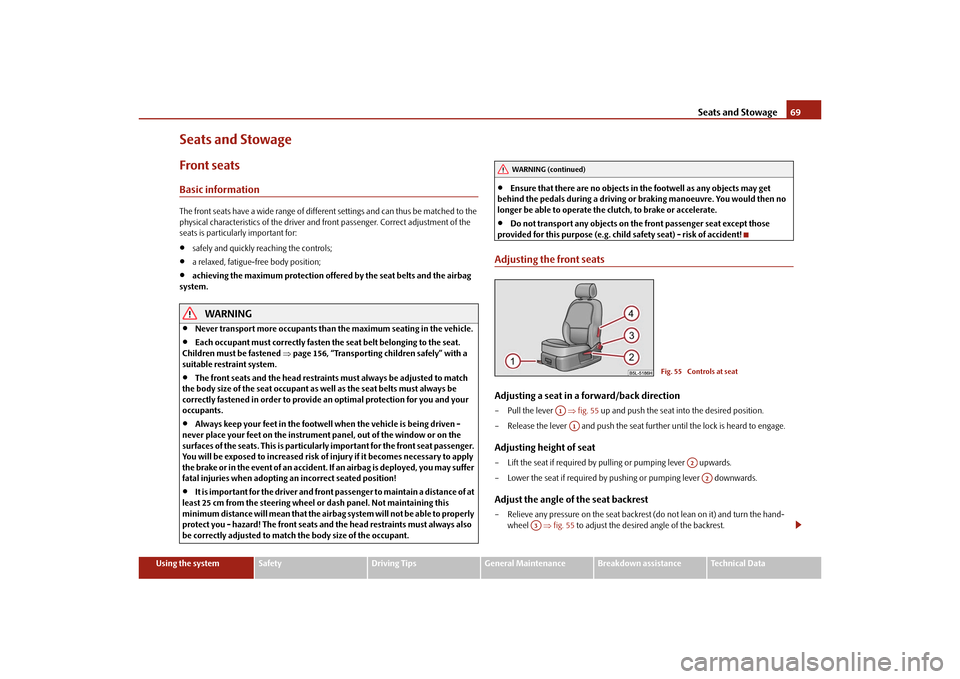
Seats and Stowage69
Using the system
Safety
Driving Tips
General Maintenance
Breakdown assistance
Technical Data
Seats and StowageFront seatsBasic informationThe front seats have a wide range of differ ent settings and can thus be matched to the
physical characteristics of the driver and front passenger. Correct adjustment of the
seats is particularly important for:
safely and quickly reaching the controls;
a relaxed, fatigue-free body position;
achieving the maximum protection offered by the seat belts and the airbag
system.
WARNING
Never transport more occupants than the maximum seating in the vehicle.
Each occupant must correctly fasten the seat belt belonging to the seat.
Children must be fastened page 156, “Transporting children safely” with a
suitable restraint system.
The front seats and the head restraints must always be adjusted to match
the body size of the seat occupant as well as the seat belts must always be
correctly fastened in order to provide an optimal protection for you and your
occupants.
Always keep your feet in the footwell when the vehicle is being driven -
never place your feet on the instrument panel, out of the window or on the
surfaces of the seats. This is particular ly important for the front seat passenger.
You will be exposed to increased risk of injury if it becomes necessary to apply
the brake or in the event of an accident. If an airbag is deployed, you may suffer
fatal injuries when adopting an incorrect seated position!
It is important for the driver and front passenger to maintain a distance of at
least 25 cm from the steering wheel or dash panel. Not maintaining this
minimum distance will mean that the airbag system will not be able to properly
protect you - hazard! The front seats and the head restraints must always also
be correctly adjusted to match the body size of the occupant.
Ensure that there are no objects in the footwell as any objects may get
behind the pedals during a driving or braking manoeuvre. You would then no
longer be able to operate the clutch, to brake or accelerate.
Do not transport any objects on the front passenger seat except those
provided for this purpose (e.g. child safety seat) - risk of accident!
Adjusting the front seatsAdjusting a seat in a forward/back direction–Pull the lever fig. 55 up and push the seat into the desired position.
– Release the lever and push the seat further until the lock is heard to engage.Adjusting height of seat– Lift the seat if required by pulling or pumping lever upwards.
– Lower the seat if required by pushing or pumping lever downwards.Adjust the angle of the seat backrest– Relieve any pressure on the seat backrest (do not lean on it) and turn the hand- wheel fig. 55 to adjust the desired angle of the backrest.
WARNING (continued)
Fig. 55 Controls at seat
A1A1
A2A2
A3
s2ug.6.book Page 69 Friday, April 9, 2010 2:24 PM
Page 72 of 271
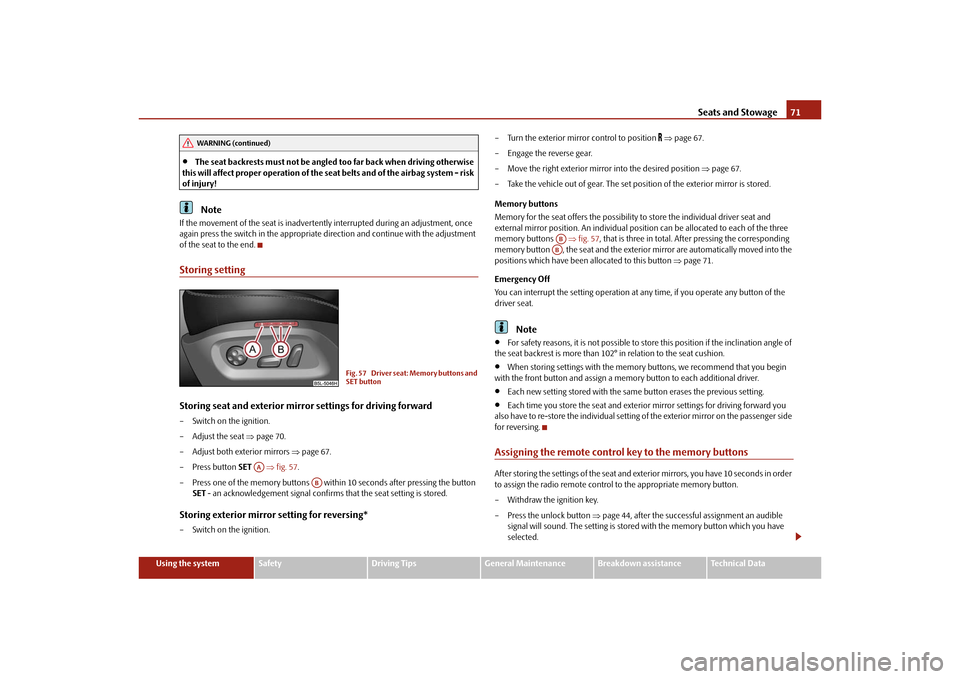
Seats and Stowage71
Using the system
Safety
Driving Tips
General Maintenance
Breakdown assistance
Technical Data
The seat backrests must not be angled too far back when driving otherwise
this will affect proper operation of the se at belts and of the airbag system - risk
of injury!Note
If the movement of the seat is inadverten tly interrupted during an adjustment, once
again press the switch in the appropriate di rection and continue with the adjustment
of the seat to the end.Storing settingStoring seat and exterior mirror settings for driving forward– Switch on the ignition.
– Adjust the seat page 70.
– Adjust both exterior mirrors page 67.
– Press button SET fig. 57 .
– Press one of the memory buttons with in 10 seconds after pressing the button
SET - an acknowledgement signal confirms that the seat setting is stored.Storing exterior mirror setting for reversing*– Switch on the ignition. – Turn the exterior mirror control to position
page 67.
– Engage the reverse gear.
– Move the right exterior mirror into the desired position page 67.
– Take the vehicle out of gear. The set posi tion of the exterior mirror is stored.
Memory buttons
Memory for the seat offers the possibility to store the individual driver seat and
external mirror position. An individual posi tion can be allocated to each of the three
memory buttons fig. 57, that is three in total. Af ter pressing the corresponding
memory button , the seat and the exterior mirror are automatically moved into the
positions which have been allocated to this button page 71.
Emergency Off
You can interrupt the setting operation at any time, if you operate any button of the
driver seat.
Note
For safety reasons, it is not possible to store this position if the inclination angle of
the seat backrest is more than 102° in relation to the seat cushion.
When storing settings with the memory buttons, we recommend that you begin
with the front button and assign a memory button to each additional driver.
Each new setting stored with the same button erases the previous setting.
Each time you store the seat and exterior mirror settings for driving forward you
also have to re-store the individual setting of the exterior mirror on the passenger side
for reversing.
Assigning the remote control key to the memory buttonsAfter storing the settings of the seat and exterior mirrors, you have 10 seconds in order
to assign the radio remote control to the appropriate memory button.
– Withdraw the ignition key.
– Press the unlock button page 44, after the successful assignment an audible
signal will sound. The setting is stored with the memory button which you have
selected.
WARNING (continued)
Fig. 57 Driver seat: Memory buttons and
SET button
AA
AB
ABAB
s2ug.6.book Page 71 Friday, April 9, 2010 2:24 PM
Page 74 of 271
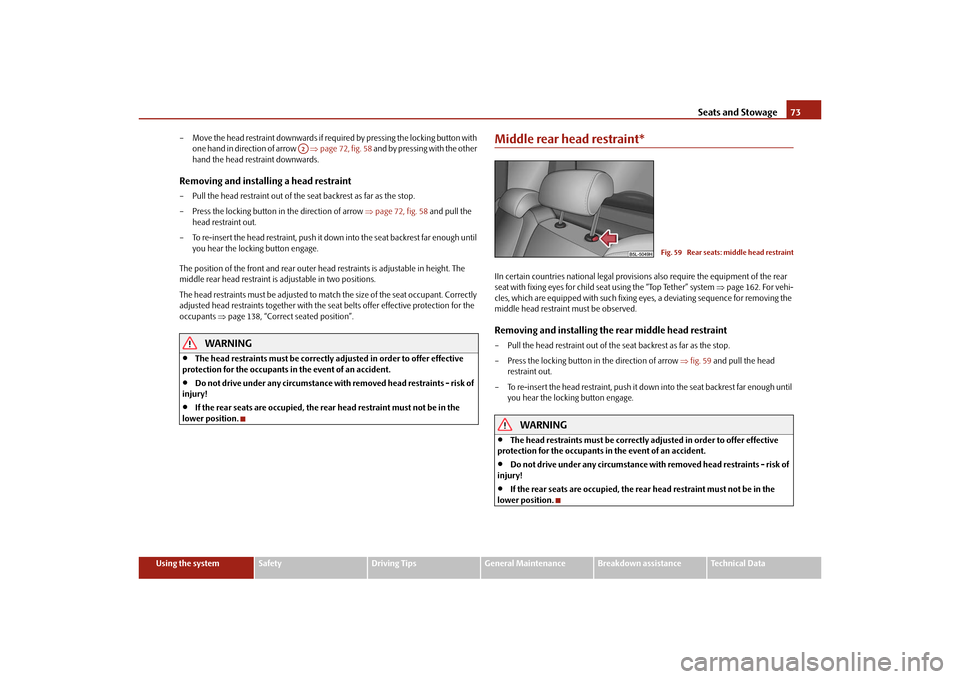
Seats and Stowage73
Using the system
Safety
Driving Tips
General Maintenance
Breakdown assistance
Technical Data
– Move the head restraint downwards if required by pressing the locking button with
one hand in direction of arrow page 72, fig. 58 and by pressing with the other
hand the head restraint downwards.
Removing and installing a head restraint– Pull the head restraint out of the seat backrest as far as the stop.
– Press the locking button in the direction of arrow page 72, fig. 58 and pull the
head restraint out.
– To re-insert the head restraint, push it down into the seat backrest far enough until you hear the locking button engage.
The position of the front and rear outer head restraints is adjustable in height. The
middle rear head restraint is adjustable in two positions.
The head restraints must be adjusted to ma tch the size of the seat occupant. Correctly
adjusted head restraints together with the seat belts offer effective protection for the
occupants page 138, “Correct seated position”.
WARNING
The head restraints must be correctly adjusted in order to offer effective
protection for the occupants in the event of an accident.
Do not drive under any circumstance with removed head restraints - risk of
injury!
If the rear seats are occupied, the rear head restraint must not be in the
lower position.
Middle rear head restraint*IIn certain countries national legal provisions also require the equipment of the rear
seat with fixing eyes for child seat using the “Top Tether” system page 162. For vehi-
cles, which are equipped with such fixing eyes, a deviating sequence for removing the
middle head restraint must be observed.Removing and installing the rear middle head restraint– Pull the head restraint out of the seat backrest as far as the stop.
– Press the locking button in the direction of arrow fig. 59 and pull the head
restraint out.
– To re-insert the head restraint, push it do wn into the seat backrest far enough until
you hear the locking button engage.
WARNING
The head restraints must be correctly adjusted in order to offer effective
protection for the occupants in the event of an accident.
Do not drive under any circumstance with removed head restraints - risk of
injury!
If the rear seats are occupied, the rear head restraint must not be in the
lower position.
A2
Fig. 59 Rear seats: middle head restraint
s2ug.6.book Page 73 Friday, April 9, 2010 2:24 PM
Page 76 of 271
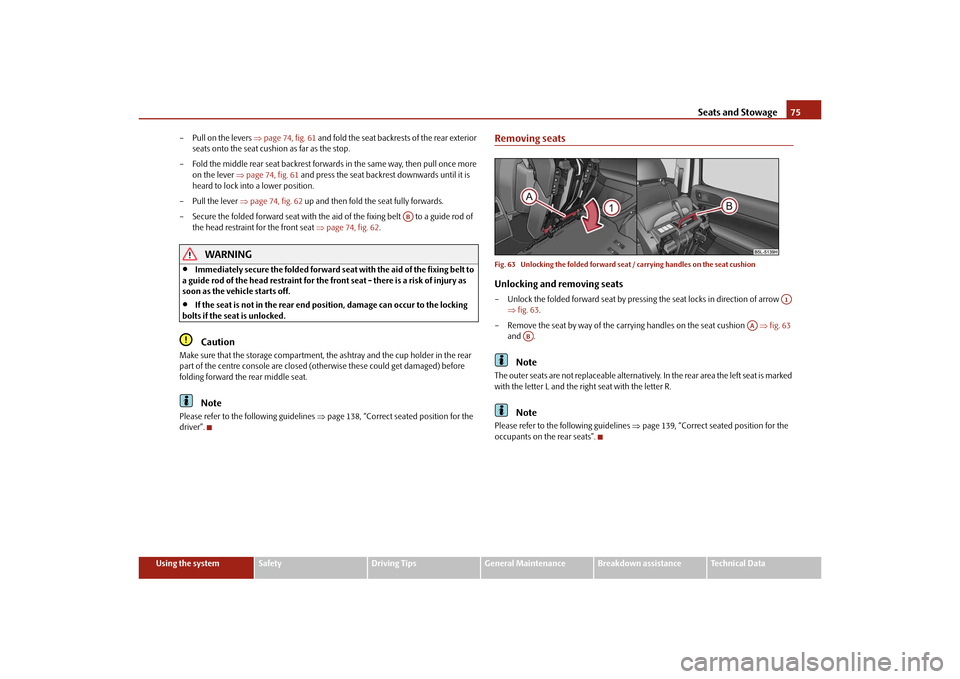
Seats and Stowage75
Using the system
Safety
Driving Tips
General Maintenance
Breakdown assistance
Technical Data
– Pull on the levers
page 74, fig. 61 and fold the seat backrests of the rear exterior
seats onto the seat cushion as far as the stop.
– Fold the middle rear seat backrest forwards in the same way, then pull once more on the lever page 74, fig. 61 and press the seat backre st downwards until it is
heard to lock into a lower position.
– Pull the lever page 74, fig. 62 up and then fold the seat fully forwards.
– Secure the folded forward seat with the aid of the fixing belt to a guide rod of the head restraint for the front seat page 74, fig. 62 .
WARNING
Immediately secure the folded forward seat with the aid of the fixing belt to
a guide rod of the head restraint for the front seat - there is a risk of injury as
soon as the vehicle starts off.
If the seat is not in the rear end position, damage can occur to the locking
bolts if the seat is unlocked.Caution
Make sure that the storage compartment, th e ashtray and the cup holder in the rear
part of the centre console are closed (o therwise these could get damaged) before
folding forward the rear middle seat.
Note
Please refer to the following guidelines page 138, “Correct seated position for the
driver”.
Removing seatsFig. 63 Unlocking the folded forward seat / carrying handles on the seat cushionUnlocking and removing seats– Unlock the folded forward seat by pressin g the seat locks in direction of arrow
fig. 63 .
– Remove the seat by way of the carrying handles on the seat cushion fig. 63
and .
Note
The outer seats are not replaceable alternatively. In the rear area the left seat is marked
with the letter L and the right seat with the letter R.
Note
Please refer to the following guidelines page 139, “Correct seated position for the
occupants on the rear seats”.
AB
A1
AA
AB
s2ug.6.book Page 75 Friday, April 9, 2010 2:24 PM
Page 78 of 271
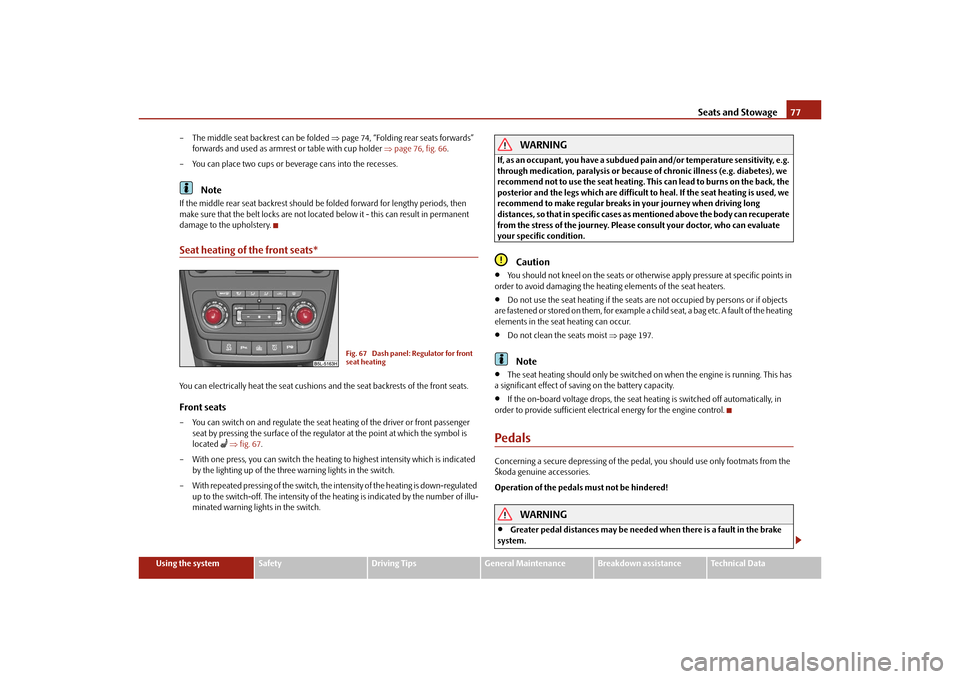
Seats and Stowage77
Using the system
Safety
Driving Tips
General Maintenance
Breakdown assistance
Technical Data
– The middle seat backrest can be folded
page 74, “Folding rear seats forwards”
forwards and used as armres t or table with cup holder page 76, fig. 66 .
– You can place two cups or beverage cans into the recesses.
Note
If the middle rear seat backrest should be folded forward for lengthy periods, then
make sure that the belt locks are not located below it - this can result in permanent
damage to the upholstery.Seat heating of the front seats*You can electrically heat the seat cushions and the seat backrests of the front seats.Front seats– You can switch on and regulate the seat heating of the driver or front passenger
seat by pressing the surface of the regulator at the point at which the symbol is
located
fig. 67 .
– With one press, you can switch the heating to highest intensity which is indicated by the lighting up of the three warning lights in the switch.
– With repeated pressing of the switch, the intensity of the heating is down-regulated up to the switch-off. The intensity of the heating is indicated by the number of illu-
minated warning lights in the switch.
WARNING
If, as an occupant, you have a subdued pain and/or temperature sensitivity, e.g.
through medication, paralysis or because of chronic illness (e.g. diabetes), we
recommend not to use the seat heating. This can lead to burns on the back, the
posterior and the legs which are difficult to heal. If the seat heating is used, we
recommend to make regular breaks in your journey when driving long
distances, so that in specific cases as mentioned above the body can recuperate
from the stress of the journey. Please consult your doctor, who can evaluate
your specific condition.
Caution
You should not kneel on the seats or otherwise apply pressure at specific points in
order to avoid damaging the heating elements of the seat heaters.
Do not use the seat heating if the seats ar e not occupied by persons or if objects
are fastened or stored on them, for example a child seat, a bag etc. A fault of the heating
elements in the seat heating can occur.
Do not clean the seats moist page 197.Note
The seat heating should only be switched on when the engine is running. This has
a significant effect of saving on the battery capacity.
If the on-board voltage drops, the seat heating is switched off automatically, in
order to provide sufficient electrical energy for the engine control.
PedalsConcerning a secure depressing of the peda l, you should use only footmats from the
Škoda genuine accessories.
Operation of the pedals must not be hindered!
WARNING
Greater pedal distances may be needed when there is a fault in the brake
system.
Fig. 67 Dash panel: Regulator for front
seat heating
s2ug.6.book Page 77 Friday, April 9, 2010 2:24 PM
Page 80 of 271

Seats and Stowage79
Using the system
Safety
Driving Tips
General Maintenance
Breakdown assistance
Technical Data
Fastening elementsFig. 68 Luggage compartment: Lashing eyes and fastening elements / attachment points and
fastening stripFixing eyes and fastening elements fig. 68 or fixing eyes and a fastening strip* are
fitted on both sides of the luggage compartment fig. 68 - right.
You can also attach the fixing nets*, for stowing small items of luggage, in the luggage
compartment on the fixing eyes and fastening elements or on the fixing eyes and the
fastening strip with integrated hook fig. 68 .
The fixing nets* and the installation inst ruction are located in the luggage compart-
ment.
WARNING
The load to be transported must be fixe d in place in such a way that it cannot
move during the journey and when braking.
If the items of luggage or objects ar e attached to the lashing eyes with
unsuitable or damaged lashing straps, inju ries can occur in the event of braking
manoeuvres or accidents. In order to prevent the items of luggage being thrown
forward, always use suitable lashing st raps which are firmly attached to the
lashing eyes.
Folding hooksFolding hooks for attaching small items of luggage, such as bags etc., are provided on
both sides of the luggage compartment fig. 69 .
An item of luggage weighing up to 7.5 kg can be attached to the hook.
WARNING
Please refer to the following guidelines page 78.Fastening strip with moveable hook*Fig. 70 Luggage compartment: Fastening strip with moveable hook / remove hookA fastening strip is located on both sides of the luggage compartment with two move-
able hooks each, in order to attach small items of luggage, such as bags etc. fig. 70 .
An item of luggage weighing up to 7. 5 kg can be attached to each hook.
Fig. 69 Luggage compartment: folding
hooks
s2ug.6.book Page 79 Friday, April 9, 2010 2:24 PM